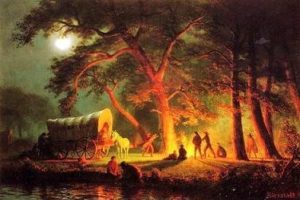
The Dalles is considered the end of the Overland Oregon Trail. After emigrants struggled over vast prairies, rocky mountainsides and battled their way through miles of dry high desert and swift flowing rivers, at the foot of the rapids of the dalles, they found themselves confronted with the Columbia River Gorge.
The geological barriers presented by the Columbia River Gorge were too much for wooden wagons, with wooden wagon wheels, pulled by a couple of oxen and loaded with everything they owned in the world. The steep, vertical basalt cliffs and deep ravines that lay ahead would provide no passageway for pioneer wagons. From this point they had to build rafts and take to the river road to Fort Vancouver, and from there they could take the Willamette River on into the Willamette River Valley. From the Dalles west to Fort Vancouver was an 88 mile stretch.

The first emigrants to pass through The Dalles were members of the Peoria Party in 1840. Inspired by a talk given by Jason Lee in Peoria, Illinois, these men were the first to travel to Oregon with the intention of settling here. Until that time, the area had been considered a temporary station for both the fur traders and missionaries.
Mountain men Joe Meek and Robert “Doc” Newell, passed through The Dalles in the fall of 1840, along with a ragged party of mountain men who had decided to become settlers. They were the first to bring a wagon across the territory that would become known as the Oregon Trail. Their small party recorded a stay at the Wascopam Mission.
In 1843, Lt. John C. Frémont, with his mountain men guides Kit Carson and Thomas “Broken Hand” Fitzpatrick, arrived at the Wascopam Mission. Frémont had been given the task to survey and map the route that would become the Oregon Trail. At the mission, they picked up a young Indian man who went by the name of “Billy Chinook,” who had been studying with the missionaries at Wascopam.
The first large wagon train over the Oregon Trail, a migration of over 800 people, arrived at Wascopam Mission in the fall of 1843. Perkins’ journal indicated they were hard pressed to feed and assist the starving travelers. 1844 brought 1,400 more emigrants, followed by 2,500 in 1845. Many would later return to permanently settle in this area.
After the beginning of the Cayuse Indian War in 1847, Wascopam Mission was abandoned as hostilities continued to grow between Native people, the influx of white settlers, and gold seekers. The government responded by establishing and garrisoning military posts along the road to Oregon, including Fort Dalles.
Eventually trading stores sprang up to provide for the needs of emigrants as well as soldiers, and a community was born. The Dalles was incorporated in 1857, making it the fourth oldest city in Oregon.
Oregon Trail pioneer Ezra Meeker retraced the epic journey in 1906, and stopped in The Dalles with his wagon and oxen. He dedicated a marker that had been made by the ladies of the Sorosis Society, and the city gathered around City Park to note The Dalles as the “End of the Oregon Trail.”
But really, where did the Oregon Trail begin? Where did it end? Historian Karen Johnson, with the Tumwater Historical Society, tells students, “Imagine a piece of rope, with frayed threads at both ends. The Oregon Trail was like that piece of rope. Imagine your personal journey being like one of those threads. It began where you began and it ended where you ended. But the bulk of those threads were bound together on a common path.”